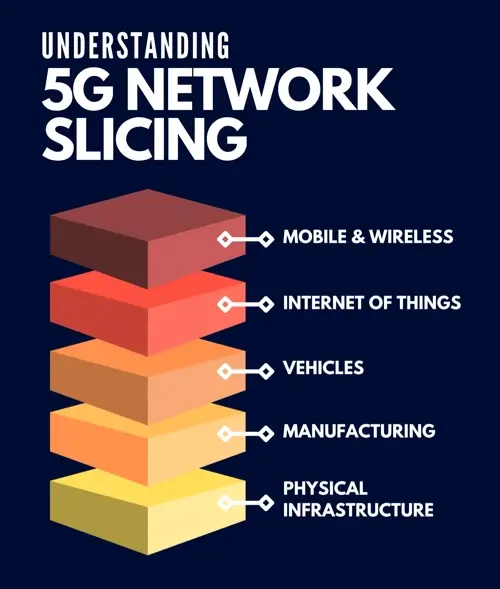What Is Network Slicing? Guide to 5G Network Slicing
5G technology promises reduced latency, improving the performance of digital experiences. However, a commercial 5G network is generally shared amongst many users. That means it may not always be able to offer the most ideal performance. Network slicing, a key feature of 5G technology, helps split the network into small virtual networks for specific use. In this article, learn what network slicing is, how its architecture works, and its benefits in 5G.
What is network slicing?
Network slicing is a technique that enables multiple virtual networks, or 'slices,' to be created on top of a single physical network infrastructure. The intention is to make better use of the network by sharing its resources more flexibly.
Slicing is an integral part of 5G communications, built on virtualized infrastructure.
Network functions run as software in data centers rather than on dedicated appliances. These 5G networks allow multiple logical end-to-end networks, each intended to meet specific requirements, to operate as needed over the same shared hardware. This capability is the essence of network slicing. In particular, it’s a mechanism for companies to provide a new breed of managed networking services to enterprise customers.
Each end-to-end slice is tailored to serve a specific application, service type, or user need. The slice operates as its own network entity with rules, speed, and security.
For example, one piece of a network could handle video streaming to achieve the needed speed and bandwidth. Another might focus on critical services like helping self-driving cars communicate to ensure their efficient operation.
The realization of network slicing leverages the accelerated use of Software-Defined Networking (SDN) and Network Function Virtualization (NFV). These advanced technologies make it possible to create quick, scalable slices.
For network operators, much of the value of network slicing comes from the potential cost savings of hosting services on common public infrastructure. Slicing provides highly flexible network services that can be dynamically allocated on demand based on service requirements. Slices can be created, modified, or removed depending on priority.

In business terms, the infrastructure provider leases parts of their physical network to Mobile Virtual Network Operators (MVNOs). These MVNOs then create multiple network slices that suit the applications they support.
How does 5G network slicing work?
Network slicing is recognized as an essential component of 5G. The technology relies on virtualization technologies to create several virtual slices. Virtualization turns physical network components - like antennas, cables, and data centers - into software-driven tools.
Slicing can occur at different levels of the 5G architecture, including the radio access network (RAN), the backhaul, and the core itself.
A network slice can guarantee diverse service agreements regarding throughput, latency, and reliability. Every slice operates independently, with its own rules to allow service providers to extend specific performance levels. If one slice has a problem, like a cyberattack, it doesn’t mess with the others.
Network slicing's power lies in its flexibility. For example, mobile service providers can physically separate traffic on different radio networks, divide a single network into slices, or combine resources from multiple networks into a shared pool.
Understanding network slicing architecture
Slicing might come about in different ways. Developers created the 5G standards with three fundamental use cases in mind: enhanced mobile broadband (eMBB), ultra-reliable low latency communications (URLLC) and mass machine-type communications (mMTC).
In other words, network operators slice their networks into three core service types:
- Enhanced Mobile Broadband (eMBB) supports high-speed Internet for a variety of users. This slice type is ideal for places with dense crowds, like stadiums, or for wide-area coverage. It also works for people on the move, such as those on high-speed trains. By using advanced technologies like massive MIMO (multiple input, multiple output) antennas and high-frequency millimeter waves, eMBB ensures fast connections.
- Massive Machine-Type Communications (mMTC) focuses on connecting a huge number of devices in a small area, such as sensors in smart cities. These devices don’t need to transfer large amounts of data. They can tolerate delays but must be energy-efficient to support long battery life. Because mMTC can handle up to one million devices in just one square kilometer, it is ideal for Internet of Things applications.
- Ultra-Reliable Low-Latency Communications (URLLC) is built for applications where speed and reliability are critical, like remote surgeries, self-driving cars, and industrial automation. The mini-network delivers data with extremely low delay - less than one millisecond - and ensures that information transmits without loss thanks to advanced signal processing, optimized antenna designs, and the use of multiple frequency bands.
Benefits of network slicing
Network slicing offers numerous advantages, from security to cost efficiency. If you use this technique, the following could benefit your network.
Enhanced security
Slice isolation in 5G keeps each slice separate from the others, even though they all share the same network infrastructure.
This separation improves security because if abnormal traffic or technical problems occur in one slice, they won’t affect the others. For example, if a hacker targets a slice used for smart home devices, the slices used for businesses will stay safe.
Better Quality of Service (QoS)
Network slicing guarantees good Quality of Service (QoS) for different applications. QoS means ensuring that speed, reliability, and connection quality meet specific needs.
For instance, a slice designed for video streaming can prioritize fast connections, while a slice for IoT devices can focus on handling many low-power connections efficiently.
Cost savings
Network operators can set up only the parts of the network needed for specific customers. In this sense, you don’t have to install everything for devices that only need a few features.
Until now, most public mobile networks have been built on the principle that all connected devices communicate using the same physical network as everything else.
This focused approach has allowed service providers to reach users across different geographies quickly while remaining cost-effective.
Efficiency and flexibility
Another plus is its flexibility to handle many different tasks. Since 5G will be used for so many things - like high-speed Internet, smart devices, and low-power sensors - each use has different needs for speed, power, and bandwidth. Network slicing permits you to adjust to these needs efficiently.
Creates revenue opportunities
By dramatically reducing barriers to service innovation, network slicing has the potential to generate revenue from new services that will justify the significant network investments required for 5G.
Support for emerging technologies
Network slicing is a fundamental tool for supporting new technologies that require high-performance networks. Network slicing facilitates the Internet of Things, which connects millions of devices to the Internet.
A smartphone, for example, needs a network slice that provides stable connections and efficiently handles data.
Faster deployment
Companies can deploy 5G systems more quickly because fewer functions need to be deployed. By skipping the extra steps, they can get their systems up and running faster.
Challenges of network slicing
Network slicing is an effective way to offer new, differentiated services to both operators and their customers. Despite the apparent upsides, however, its adoption isn’t without challenges.
Enterprise security concerns with managing slices
One big challenge is securing network slices when enterprises manage their slice settings. The network slice management process lets businesses control how their slice operates.
However, if hackers break into this system, they could affect important parts of the network and cause serious problems, such as service shutdowns.
Uneven security across devices
There’s also the risk of weak spots in security between devices. For example, simple IoT sensors with lower security might be an easy target for hackers. Once inside, they could jump to another slice with more sensitive information, like personal data from phones or smart home systems.
Resource overload and slice interdependence
Network slices often share storage, processing power, and network functions. If one slice uses too much - for example, because of a large reboot - it can affect the performance of other slices.
This could prevent some slices from following proper security protocols. This is a serious issue for industries that rely on consistent performance, like healthcare.
Confusion and lack of awareness
Network slicing is still new, and many businesses don’t fully understand how it works or its benefits. Even the companies providing network slicing are figuring out the best ways to manage these services. The lack of clear communication makes some enterprises skeptical about adopting the technology.
When is network slicing used?
Most businesses have relied on one shared network for noncritical work. But as more devices require connectivity as part of the Internet of Things, businesses are exploring connectivity use cases that align with performance, high availability, scalability, and security. That’s what network slicing supports.
Teleoperated driving
Teleoperated driving allows drivers to directly control an autonomous-capable vehicle from a remote location, such as a control center, during certain periods of time. Potential uses for teleoperated driving would include operating industrial vehicles in wide-area applications.
The key features of teleoperated driving enabled by slicing include high availability, ultra-low latency, and real-time HD video streaming enabled by high throughput.
Remote treatment in emergencies
Remote treatment during emergencies could save more lives through earlier identification of an emergency condition. To work, however, video streams must not break and must maintain high resolution. Delay, lag, or poor quality will interfere with diagnosis, so connectivity must have a high quality of service.
A 5G network slice can provide this level of QoS, with HD video streaming from emergency vehicles to waiting rooms enabled by five-nine availability.
Surveillance and monitoring
In the government, Public Safety Authorities (PSAs) use surveillance and monitoring to proactively manage public safety. The success of surveillance technologies is dependent on the key enabling factor: connectivity.
Several challenges must be overcome to harness the growing opportunity in the public sector. For one, many government departments operate in silos, with little cooperation between them and their legacy systems.
Network slicing breaks down data silos and enables sharing across agencies while meeting security requirements. The configurability of 5G slicing allows for the management of all wireless access points with a single, secure network.
Media and entertainment
Network slicing can offer special lanes for high-quality streaming, virtual reality (VR), or augmented reality (AR) applications for media and entertainment. These slices ensure users get immersive experiences, whether watching a movie or exploring a virtual world.
Frequently asked questions
What is end-to-end network slicing in 5G?
End-to-end network slicing in 5G divides the entire 5G network into virtual segments aimed at specific needs.
Why is network slicing required in 5G?
Slicing is required in 5G to meet the diverse needs of different applications and industries.
What is an example of 5G network slicing?
An example of 5G network slicing is its use in autonomous vehicles. A car manufacturer might request a slice with ultra-reliable, low-latency communication (URLLC) to ensure real-time control and data exchange between the car and the cloud.

